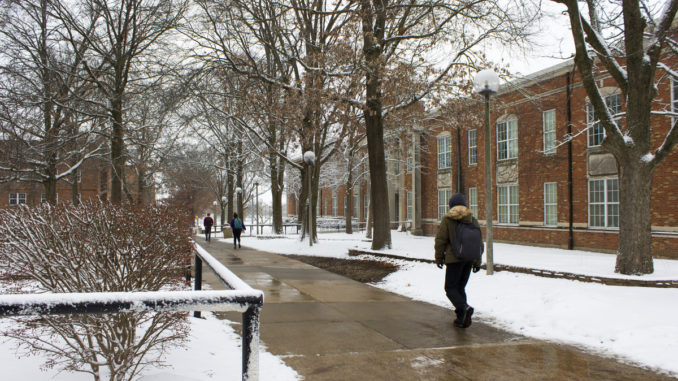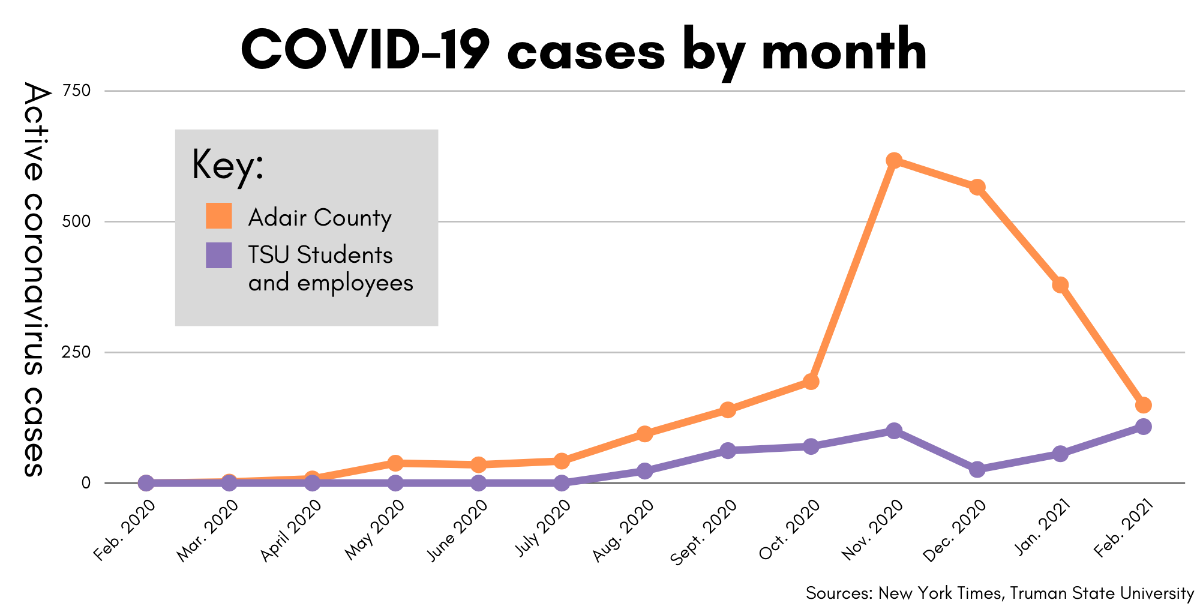
The Adair County Health Department has recently transitioned to only contact tracing within households, but Truman State University has continued contact tracing for all close contacts.
The Adair County Health Department has two contact tracers and is refocusing its efforts because of the decrease in COVID-19 cases.
When the Adair County Health Department is notified of a positive case, it investigates the patient’s household contacts. Household contacts live in the same house or share a bathroom, kitchen or living space.
After determining who a person’s household contacts are, the Health Department encourages them to quarantine for 10 days. The Health Department also requests that those who test positive ask their other close contacts to quarantine for 10 days.
The Centers for Disease Control and Prevention still recommends close contacts quarantine for 14 days.
Adair County has changed its strategy because of a decrease in the number of positive COVID-19 cases.
“If you look at our positive cases right now, we’ve seen several things happen,” Jim Lebaron, Adair County Health Department administrator, said. “I would say that our people in isolation right now are probably half of what our high was, as far as people that we had in isolation at one time, and as of [Feb. 16] we’ve got approximately 55 people that are in isolation and so that’s about half of where we were, so that’s really good. The other thing is that we are seeing a decline in the number of people 65 and older that are positive and that’s another good thing.”
As of Tuesday, Feb. 23, there were 30 active COVID-19 cases in Adair County.
At Truman, Nancy Daley-Moore, assistant professor of health and exercise science, leads the contact tracing process. The group of about 20 people, consisting of volunteers and paid staff, are continuing to do contact tracing outside of just household contacts.
“We are a little different than Adair County because Adair County is just doing households and I talked to Adair County and I was like, ‘We can’t do that,’ so we’re doing household contacts and outside of the household,” Daley-Moore said. “So this includes anybody that you’re not living with is still being contacted at Truman.”
Daley-Moore said Truman will continue contact tracing both within and outside the household because it is still considered the gold standard recommended by the CDC.
Daley-Moore said the University also has the means to do the more extensive contact tracing, which is beneficial for the kind of spread occurring at Truman.
“I am concerned as a public health person if we don’t start getting those people, then we’re going to have more spread because I do have data to show people who aren’t household contacts are also testing positive,” Daley-Moore said. “So I think just from a campus safety perspective, we need to do that as long as we can.”
Daley-Moore said the number of cases last week has been lower than in the past, as have the number of contacts for each positive case. This semester, she said most positive cases have about one to three contacts that are traced and contacted.
The number of active cases on Truman’s campus has decreased to 14 cases as of Feb. 23. Contact tracers on campus have usually been investigating cases and close contacts within 24 hours. This efficiency has contributed to the slower spread of COVID-19 on campus.
In the fall semester, Daley-Moore said the University contacted roughly 1,000 people at least once.
If a Truman student tests positive for COVID-19, they are interviewed by the University’s contact tracers. The individual that tests positive is asked if they have been in contact with anyone for 15 minutes and within six feet unmasked. Daley-Moore said if the contact was close to these measures, maybe 11 minutes instead of 15, they will also be contacted.
“We typically contact them every day or every other day to follow up with them, and that’s usually by phone or email, so it involves a lot of just leg work, especially now that we dropped down to the 10-day [quarantine] — and part of being able to do a 10-day quarantine is staying asymptomatic so really trying to get in touch with them is really important,” Daley-Moore said.
The 10-day quarantine is only available for individuals that test positive but are asymptomatic. If any symptoms develop, that individual is required to quarantine the full 14 days. While symptoms typically develop before 10 days, Daley-Moore said it is possible for symptoms to develop on day 14.
Daley-Moore said part of the reason for the move from a 14 to 10-day quarantine is issues with compliance, as well as fewer contact tracers in Adair County, community support for decreased quarantine times and declining rates in the county.
“The local health department has the authority, and so when they went down, I had to go down as well,” Daley-Moore said. “It’s to help with compliance and recognize the burden that quarantine is. And we do have issues with compliance — it’s hard to convince some people to quarantine.”
Daley-Moore said she gets a report about once per week that someone is not complying with quarantine or is having some difficulty staying isolated.
She said some people prematurely leave quarantine because of a misunderstanding of their release date, while others leave because they grow tired of the process or don’t believe it is real.
“I try not to fault them too much because I understand it’s difficult and people are making these choices, so it’s more of a how can I negotiate with you to quarantine,” Daley-Moore said.
The number of cases and contacts varies each week, which makes scheduling contact tracers more difficult, Daley-Moore said. Truman saw its highest number of cases during the last week of January. Daley-Moore said they had 16 cases reported on a single day that week, which was the most in a single day. She said since then, cases have decreased, so there are some days no cases are reported at all.
Daley-Moore said she has noticed a lot of spread within households from the data gathered from contact tracing. She said this semester, more contacts have been testing positive as well.
Daley-Moore said she is concerned about Spring Break and its potential for spreading the virus after seeing the number of cases the University had after winter break. She said she recommends safe decision-making and planning before leaving the University and before returning.
Even though there has been a decrease in cases, residents of Adair County and the Truman community members are still encouraged to remain vigilant and continue to take preventative measures.

